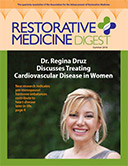Learn more about curcumin and other herbal medicines at the Restorative Medicine Herbal Certification program. More information HERE.
Curcumin has recently experienced a surge in popularity with integrative medical practitioners and the retail dietary supplement industry, due to its excellent antioxidant and anti-inflammatory properties. Data from SPINS (natural products retail sales statistics) reported that curcumin sales exceeded $20 million in 2014, representing a 26% growth from year prior. But why is use of this ancient herb exploding now?
Curcumin, an active component of the Indian spice turmeric, is finally getting the recognition it deserves as one of the most extensively-researched herbs, accumulating more than 9,000 published research studies. It’s a much-needed solution to fill a gap in prescription medicines, by helping to reduce inflammation and preserve brain health. Its traditional and current applications include anti-cancer and anti-inflammatory activity, along with preventing dementia, liver disorders, arthritis, joint pain, and much more.
The one major obstacle for curcumin efficacy is limited bioavailability in its natural form. As a result, recent research has investigated new technologies to optimize its absorption in supplements. These studies were recently reviewed in a paper by curcumin expert Ajay Goel, PhD. Dr. Goel is a NIH-funded researcher from Baylor University Medical Center in Dallas, Texas. His research interests include the epigenetics of gastrointestinal cancers, DNA methylation, biomarkers for cancers, and chemoprevention through complementary and alternative approaches. He has conducted and published extensive research on curcumin, including a review article published in the peer-reviewed Journal of Restorative Medicine, focused on the issue of bioavailability.
Multiple Challenges Related to Curcumin Bioavailability
As described in the article, the problem of curcumin’s low bioavailability has driven extensive research into new technologies which can potentially be applied to the manufacture of high-absorption curcumin supplements. A secondary obstacle is how to best provide evidence which validates improved absorption, as there is much controversy about the accuracy of testing methods used for quantifying absorption. Other challenges include proper identification of molecules which best reflect absorption, how to best assess bioactivity, and how absorption correlates with clinical efficacy.
Three factors are attributed to poor bioavailability: low water solubility; poor absorption; and curcumin’s conversion to other metabolites which may or may not be traceable. To compound those problems, according to some fecal studies, a significant proportion of curcumin is excreted rather than absorbed.
Clinical Efficacy vs. Bioavailability - Which Wins?
It may be possible that concerns about absorption aren’t even warranted. Of the more than 9,000 published studies, a significant number were clinical trials that support the efficacy of curcumin in humans for various clinical conditions, regardless of bioavailability factors. The author suggests that these positive clinical results could be explained by the actions of unrecognized bioactive metabolites of curcumin, which we don’t fully understand. The author questions if researchers are really tracking the correct curcumin molecules in their absorption studies.
Optimizing Curcumin Absorption via Novel Technologies
In a review of curcumin formulas manufactured using advanced technologies, claims are made that absorption is enhanced by 5-to-30 fold. This review article assesses the various technologies and highlights each of their benefits, pitfalls, or safety concerns.
One technology which reports the highest absorption rates uses nanoparticle formulations. Nanoparticle technology shrinks and coats curcumin molecules, making them soluble in water. It has the advantage of crossing the blood-brain barrier, and preclinical trials offer hope in treating many diseases, including Alzheimer’s disease, asthma, and heart failure.
Liposomal technology improves curcumin absorption by applying a coating over the active molecule which improves water solubility. This technique is said to improve absorption, and in some situations, acts as a means for sustained-release.
Piperine extract from Piper nigrum is an additive used to enhance curcumin absorption. A potential side effect that concerns some researchers is that piperine may inadvertently enhance absorption of unwanted compounds or medications.
Considered a more natural process, some formulas blend turmeric essential oils with a proprietary extract of curcumin. This technique may not spike absorption as much as the previously listed technologies. However, studies suggest the curcumin remains in systemic circulation longer. This form offers a full-spectrum of curcumin constituents and may be preferred by some practitioners who appreciate this more natural approach.
Despite the existence of more than 9,000 studies, the author surmises that there is still much left to learn about curcumin compounds, bioavailability, and bioactivity. With so many variables to consider, it is difficult to make a fair comparison between the many curcumin technologies. In the end, a mix of different forms of curcumin may be the solution- let clinical results be the best judge of product quality!
